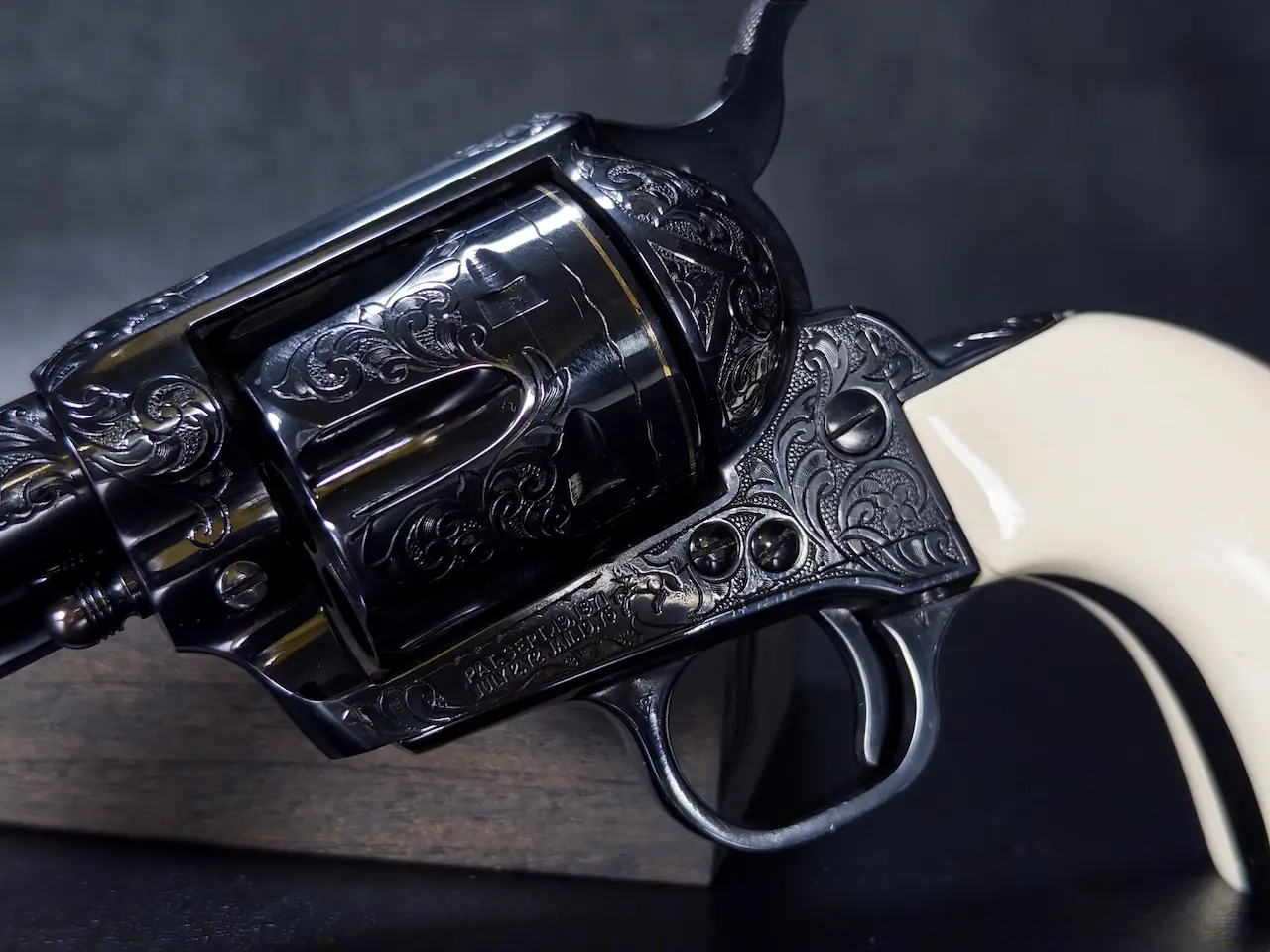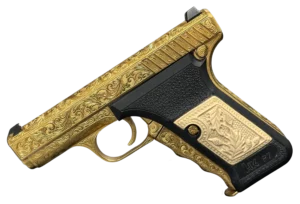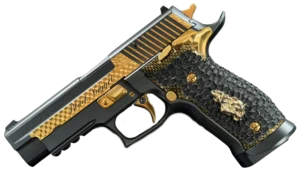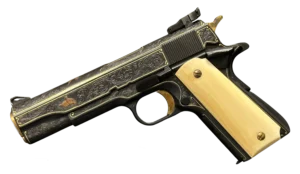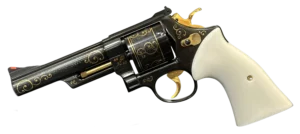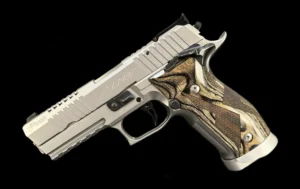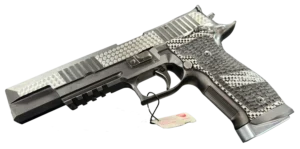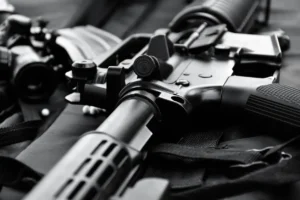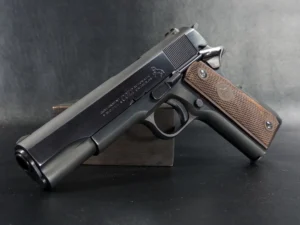Key Takeaways:
- Direct lineage to a vanishing American craft: David Wade Harris represents the third and likely final generation in an unbroken 90-year tradition of Texas cattle-brand firearm engraving. His direct training under Weldon Bledsoe, who learned from the originator, Cole Agee, in the 1950s, makes him the only living engraver with an authentic transmission of techniques dating back to the 1930s. With fewer than 500 total authenticated pieces created across three generations, Harris’s work documents both exceptional craftsmanship and American Western heritage.
- Traditional methods in a modern world: Harris remains one of perhaps two engravers worldwide who hand-forge their own tools using 300-year-old techniques, working exclusively with hammer and chisel without power assistance. His four-step process, which utilizes beeswax, talcum powder, mental visualization, and a special chisel design passed down through Agee to Bledsoe, distinguishes his work from contemporary laser engraving and power-assisted methods. This absolute fidelity to historical process over efficiency creates pieces that are both functional art and living demonstrations of disappearing craftsmanship.
- Investment value tied to cultural preservation: Harris’s signed work currently commands over $ 4,000 at premier Western firearms auctions, with pricing reflecting accessibility rather than premium positioning compared to six-figure European masters. As the tradition’s current terminus and potential final practitioner, his authenticated pieces represent both historical documentation of Texas ranching heritage and appreciative investments. The succession question—whether his daughter Tiffany successfully continues the exact traditional methods—will significantly impact the historical importance and market value of the work produced during Harris’s active years.
Let’s get started…
David Wade Harris is the final living link to a nearly century-old American engraving tradition that began in a Fort Worth workshop in the 1930s. At 62, working from his solitary Texas shop, Harris remains one of perhaps two engravers worldwide who still craft their own tools using methods unchanged for 300 years: a hammer, a chisel, and an unwavering commitment to preserve what his mentor called “the legendary engraving style.”
His craft is cattle-brand engraving, a distinctly Texan art form featuring full-coverage depictions of historic ranch brands on firearms, primarily single-action revolvers. When Harris’s wife gifted him an engraved pistol by master engraver Weldon Bledsoe one Christmas in the 1980s, it sparked an obsession. But Bledsoe, then in his 60s, had grown skeptical after previous apprentices abandoned the tradition. He tested Harris’s commitment: would he promise to keep this dying art alive, or find another teacher? Harris promised. He became Bledsoe’s last apprentice, the third and possibly final generation in an extraordinary lineage that traces directly to Cole Agee, who originated cattle-brand engraving in the late 1940s.
“My craft is the same today as it was a hundred years ago,” Harris says, “so I feel I have a chance to show others a piece of historical art.” Working full-time since 1985, he has engraved for Texas Rangers, international collectors from Alaska to Japan, and completed major commissions including 200 Winchester Model 94 rifles for America Remembers in 1992. Recent auction results show his signed work commanding $4,130 for a gold-finished 1912 Colt SAA at Brian Lebel’s Old West Auction. As laser engraving dominates commercial markets and European masters command six figures for elaborate bulino work, Harris occupies a unique niche preserving an American Western heritage that would otherwise vanish.
A lineage measured in hammer strikes, not hours
The genealogy of cattle-brand engraving reads like a spiritual succession. Cole Agee (1901-1955), the originator, created perhaps 15-20 cattle-brand guns before his death, which are so rare that only four confirmed signed pieces exist. Born in Runge, Texas, Agee first received his transformative commission in the late 1940s when Mexican President Miguel Aleman requested a unique Colt Single Action Army revolver. Agee’s wife suggested using actual Texas cattle brands from a booklet published for the 1936 Texas Centennial. The result revolutionized Western firearms art.
Weldon Bledsoe (1916-unknown), a World War II B-17 pilot who flew 25 missions, met Agee in Fort Worth around 1950. Unlike many craftsmen who guard techniques, Agee “readily shared his skills and special shortcuts,” according to Harris. Bledsoe mastered the style and produced an estimated 300-400 cattle-brand guns over his career, always including his personal mark, the “2 Lazy 2 P” brand. He could complete a full cattle-brand gun in about eight hours; Agee could finish one in under six.
Harris remembers watching his aging mentor work with reverence: “Weldon was older now, and his hands would shake a lot. He would hold his hammer in one hand and his chisel in the other. As his tools approached the work, they would shake uncontrollably. Still, when they made contact with the workpiece, they were under absolute control. Weldon was amazing to watch as he worked.”
Bledsoe’s eyesight began to fail near the end. Harris recalls a hospital waiting room encounter: “He could only see out of one eye for about the last year that he engraved. He went blind before he died. I walked up and shook his hand. He said, ‘I know you, I recognize your voice, but I can’t see who you are.'” Despite his deterioration, Bledsoe maintained his commitment to the craft and to ensuring someone would carry it forward. Harris was that someone.
The secret technique: beeswax, talcum powder, and visualization
Harris’s four-step process sounds deceptively simple. First, rub beeswax onto the metal surface to be engraved. Second, dust talc or baby powder over the wax to create a white drawing surface. Third, sketch the design into the powder. Fourth, use a hammer and a chisel to cut the pattern into the steel. But the real magic happens before any tool touches metal.
“After looking at an area over for a little while, a pattern just comes to mind or is visualized,” Harris explains. “Once I see the pattern in my mind… I really trace the image that I see there.” This mental visualization distinguishes master engravers from technicians. As Bledsoe taught him, an engraver doesn’t simply pick up a hammer and chisel and start working, any more than a painter randomly daubs strokes on a canvas. The design must exist fully formed in the artist’s mind before it can be created.
The physical execution relies on a special chisel design passed down through all three generations from Agee to Bledsoe to Harris. “I use many different types, sizes, and shapes of chisels,” Harris notes, “but about 90% of my work is done with the chisel that Weldon taught me to make, the same as Cole taught him to make. It is the key to this craft or way of engraving.” Harris hand-forges these tools himself, one of two engravers worldwide who maintain this practice. Most contemporary engravers purchase manufactured tools or use power-assisted equipment. Harris uses neither.
The results are unmistakable. His cattle-brand work features authentic historical Texas brands, such as the “101” and “XIT,” and hundreds of others from the 1880s to the 1920s, a golden age of open-range ranching, densely arranged on punch-dot backgrounds. The coverage is complete, transforming entire revolvers or rifle receivers into catalogues of Western heritage. Beyond cattle brands, Harris executes traditional American scrollwork in the styles of 19th-century masters, such as L.D. Nimschke and Cuno Helfricht, Native American symbolism (such as thunderbirds, lodges, and Zias), and historically accurate patterns like the “Sears Pattern,” which collectors prize.
Notable documented works: from presentation pieces to Native American symbolism
While the 1902 Colt SAA, 1912 Colt SAA, and Texas Rangers 1911 are already known to collectors and represent excellent examples of Harris’s work, additional documented pieces reveal his versatility:
The America Remembers Winchester 94 Series (1992) remains his most significant commercial recognition, a signed and numbered edition of 200 rifles with famous cattle brands commissioned by the commemorative firearms company. This project demonstrated both artistic consistency across large production runs and industry validation of his status as Bledsoe’s legitimate successor. He currently works on a similar series: 100 Henry rifles in progress.
A 1901 Colt SAA with extensive Native American symbolism sold at Brian Lebel’s Old West Auction (Lot 511, January 2019) showcases his range beyond cattle brands. The piece features thunderbirds, clouds, lodges, Zias, animals, and arrows in tight scrollwork with a 99% gold wash finish and carved ivory grips depicting an Indian chief. This demonstrates Harris’s ability to execute thematic variations while maintaining technical excellence.
An 1884 Colt SAA Black Powder (Rock Island Auction Lot 76-3375) features traditional floral scrollwork on punch-dot backgrounds, with fan motifs on the recoil shield, loading gate, and backstrap, demonstrating that Harris excels in classical engraving styles, not merely cattle brands. According to collector observations, Harris’s scrollwork and Bledsoe’s “can be difficult to differentiate,” the ultimate compliment in a tradition valuing continuity over innovation.
A 1878 Colt Frontier Six-Shooter held in Harris’s personal collection for over 20 years epitomizes what he considers museum-quality work. This all-matching antique features the rarest Texas brands, including Stephen F. Austin’s Spanish brand, with the coveted acid-etched “Colt Frontier Six-Shooter” panel intact. Harris kept this piece for two decades before offering it for sale, which suggests the high standard he sets for exceptional execution.
An 1883 Colt SAA “Peacemaker” in .44-40 caliber appeared at the French auction house Paul Bert Serpette, featuring foliage scrolls, numbers, hearts, and stylized letters on circled backgrounds, with antler pad grips and unusual engraved formulas (“22P,” “TI,” and infinity symbols). This piece’s appearance in European markets demonstrates Harris’s international collector appeal; his work reaches from Texas to Japan, Alaska to France.
Additional auction-documented pieces include a 1894 Colt Frontier Six-Shooter with relief-carved steer head grip featuring studded eyes and a gold bull nose ring; a 1981 third-generation Colt SAA with 50% floral coverage; a 1910 Colt 1902 Military semi-automatic in cattle-brand style (showing he works beyond revolvers); and multiple first-generation Colts in various calibers and barrel lengths. Each comes with a signed authentication letter from Harris, crucial for establishing provenance.
The business of preserving tradition: pricing, process, and market position
Harris works by appointment only, reflecting the old-school, personal nature of commission work. Pricing starts at $1,495 and up for firearms, determined not by material (stainless steel costs the same as blued steel) but by detail density, background complexity, and coverage percentage. Harris describes these rates as “very reasonable” and compares them to European masters who command $100,000 or more for elaborate shotgun engraving, or even mid-tier American engravers charging significantly more; his pricing reflects accessibility rather than a premium positioning.
For luxury watch engraving, a growing side business where he applies cattle brands, family crests, and Western themes to Rolex, Tag Heuer, Hamilton, Tudor, and other timepieces, prices range from $1,000 to $20,000 depending on coverage and complexity. The process involves deep relief engraving on hardened stainless steel (requiring constant carbide graver sharpening), often exceeding 100 hours of hand work per piece, with black epoxy resin baked into backgrounds at 122°F for contrast and durability.
Wait times remain undisclosed publicly, a common practice among high-demand custom engravers who prefer not to commit to specific timelines or reveal the depth of their backlog. Given that Harris works entirely by hand, uses no assistants (beyond teaching his daughter), and maintains an international clientele, prospective clients should expect substantial lead times. The absence of specific wait time information online likely reflects both the private nature of high-end commission work and the desire to evaluate each project individually before committing to delivery schedules.
The commission process begins with Harris visualizing the pattern, drawing it on a beeswax-and-talc surface, and then executing it with a hammer and chisel in solitude. He works alone, as his mentors did, without power tools or modern shortcuts. Every piece is original, hand-signed “DW Harris” or “DWHARRIS” (typically on the butt), and accompanied by an authentication letter that increases collectability and future provenance.
Market performance validates his approach. The $4,130 result for his gold-finished 1912 Colt SAA at Brian Lebel’s June 2019 auction represents solid but not spectacular pricing reflecting both the current market for cattle-brand style and Harris’s position as a living engraver (deceased masters’ work typically commands premiums). As the tradition becomes rarer and Harris eventually retires or passes away, his authenticated pieces are likely to appreciate significantly, following the pattern of Agee’s work (extremely rare and valuable) and Bledsoe’s growing collectibility.
Client perspectives and collector opinions: quality recognized, testimonials scarce
Direct client testimonials about Harris’s firearm engraving remain surprisingly scarce in public forums, a pattern common among high-end custom gun work, where clients typically connect through personal networks, word-of-mouth referrals, and private dealer recommendations rather than online reviews. The available evidence suggests strong respect for his technical execution, but limited public discussion of the commission experience itself.
On the Colt Forum, a collector inquiry reveals both interest and hesitation: “Anyone here have a gun Mr. Harris has engraved that is not a cattle brand? I’m not a fan of cattle brands in general, regardless of who created them. The majority of the photos on Harris’s website are terrible. But from what I can find of his work in decent photos, I like it a lot.” This comment highlights two critical points: Harris’s website photography doesn’t adequately showcase his craftsmanship (a common failing among artisan craftspeople who prioritize work over marketing), and his non-cattle-brand engraving also commands respect among discerning collectors.
Auction house descriptions consistently praise his work, using terms like “excellently executed,” “masterfully embellished,” and “museum-quality.” However, these terms likely represent promotional copy rather than independent client assessments. His pieces are regularly described as “documented” and “authenticated,” noting his direct lineage to Cole Agee through Weldon Bledsoe’s provenance, which adds both romantic appeal and financial value.
Watch engraving customers provide more detailed feedback: “Mr Harris is a Master Engraver, and it shows in the quality of his work and his well-known reputation. He did a custom job on my Hamilton Khaki King II, blacked it in, and custom-engraved my name on the clasp. It’s a Master Piece on my wrist. I will be purchasing another one in the future.” Another states: “I’ve purchased three watches and highly recommend them. The craftsmanship is unparalleled.” These testimonials, while focused on watches rather than firearms, demonstrate Harris’s consistency across different applications of his core engraving skills.
The Canadian Gun Nutz forum features an enthusiastic collector sharing photos of an 1889 Colt SAA in .41 LC “completely restored and engraved by master engraver David Wade Harris of Jacksonville, TX in the 1980s” in the Texas Cattle Brand motif with buffalo bone grips, noting “Thought I’d share some pictures before it’s gone…Enjoy!” This post reflects a sense of satisfaction and pride of ownership, although it stops short of detailing the commission process.
America Remembers’ 1992 commission of 200 Winchester 94 rifles represents perhaps the strongest institutional endorsement of a company specializing in commemorative firearms, trusting Harris with a large-scale series production that required consistency, deadline adherence, and artistic excellence across every piece. This commission wouldn’t have occurred without confidence in both his technical abilities and business reliability.
The general collector sentiment across forums and auction catalogs positions Harris as a legitimate continuation of the Agee-Bledsoe tradition rather than an imitator or derivative artist. Phrases like “carries on the cattle brand style that Cole Agee made famous” (American Rifleman) and “wonderful tribute to the style’s inventor” appear consistently. His work is sought by serious Western Americana collectors, Texas Rangers, law enforcement agencies, and international buyers, which suggests confidence in both authenticity and investment value.
Awards and professional recognition: legitimacy through lineage, not formal honors
Unlike some contemporary engravers who accumulate FEGA (Firearms Engravers Guild of America) Master Engraver designations, “Gun of the Year” awards, or competitive exhibition wins, Harris’s professional recognition primarily stems from historical legitimacy and commercial validation, rather than organizational honors.
No confirmed FEGA membership or Master Engraver designation from that organization appears in the available documentation, although this absence doesn’t necessarily indicate non-membership; FEGA directories weren’t fully accessible during the research. Many legitimate master engravers work independently of professional organizations, particularly those in specialized regional traditions, such as cattle-brand engraving.
The 1992 America Remembers commission represents his most significant documented recognition: being selected to engrave 200 Winchester Model 94 rifles in the “The American Cowboy Tribute” series. America Remembers, a major player in commemorative firearms, doesn’t select engravers lightly. This commission validated Harris’s technical consistency, artistic vision, and ability to maintain quality across large production runs, while honoring the tradition of cattle branding.
Media recognition includes a 2018 American Rifleman article (“Rifleman Q & A: Cattle Brand Colts” by Rick Hacker), which identifies Harris as carrying on “the cattle brand style that Cole Agee made famous,” alongside other master engravers. SoulVision Magazine profiled him as a “Historical Artisan,” and multiple auction houses (Brian Lebel’s Old West Auction, Rock Island Auction, French house Paul Bert Serpette) consistently describe him as a “master engraver” with authentic lineage.
Auction presence itself constitutes recognition. Harris’s work appears regularly at premier Western firearms auctions, such as Brian Lebel’s Cody Old West Auction and Santa Fe events, Rock Island Auction Company sales, and international venues. These auction houses carefully vet engravers before featuring their work, and repeated inclusion signals market confidence and collector demand.
His most important recognition comes from Weldon Bledsoe’s choice. After previous apprentices failed to maintain the tradition, Bledsoe selected Harris as his final student and trusted him to preserve nearly a century of accumulated knowledge. In craft traditions valuing lineage and direct transmission, this selection carries more weight than any organizational award. Harris was entrusted with a cultural legacy, not merely taught a technical skill.
The contemporary engraving field awards prizes for innovation, elaborate gold inlay, photorealistic bulino work, and technical virtuosity. Harris pursues none of these. His “award” is being the last living repository of an American tradition that otherwise would have died with Bledsoe. For collectors of Western Americana and Texas heritage, this cultural role matters more than competition trophies.
The contemporary landscape: where Harris fits among today’s engravers
The firearm engraving world in 2025 divides sharply between mass-market laser engraving (dominating commercial production and NFA markings), European-trained masters (commanding premium prices for elaborate bulino and relief work), American scroll engravers (maintaining classical styles), and specialist traditionalists like Harris who preserve regional historical styles.
Ken Hunt, called “the godfather of gun engraving,” created 2,666 guns over 60+ years before retiring in 2011, revolutionizing the field with elaborate gold-inlay techniques. Firmo Fracassi is considered the world’s finest bulino engraver, creating photorealistic images through millions of hand-punched dots. G. Stoegner, now retired, was Krieghoff’s top engraver with seven “Guns of the Year” awards and work commanding six-figure prices. These represent the field’s pinnacle in terms of technical complexity and market value.
Contemporary American masters include Michael Gouse (factory engraver for High Standard and Ballard, continuing American scroll traditions), Geoffroy Gournet (European-trained, former sole Parker Reproduction engraver who works without power tools for 15 years), Rex Pedersen (FEGA Master Engraver and teacher), and Jim Downing (nearly 50 years specializing in 1911s and Old West guns). These engravers represent excellence in classical and contemporary styles.
Kelly Laster emerges as perhaps Harris’s closest contemporary peer, also practicing cattle-brand engraving and described as executing the style “excellently” as a “wonderful tribute to Cole Agee.” Yet even Laster’s work doesn’t carry the direct Agee-Bledsoe-Harris lineage that provides historical authentication to Harris’s claims as the tradition’s legitimate inheritor.
The FEGA (Firearms Engravers Guild of America), founded in 1981, serves as the field’s primary professional organization, publishing “The Engraver” magazine quarterly, maintaining historical databases, certifying Master Engravers, and hosting annual conventions with awards competitions. Yet many significant engravers work independently of FEGA, particularly those in specialized regional traditions or outside the competitive exhibition circuit.
Market trends indicate that the engraving services industry is projected to reach $ 432.32 million by 2030, up from $ 273.47 million in 2024. However, this growth is primarily driven by laser engraving ($8-$300 per firearm), corporate orders, and mass customization, rather than the hand-engraved collector market where Harris operates. Hand engraving by recognized masters represents a small, specialized segment where prices start at $800-$1,500 for basic coverage and can exceed $100,000 for elaborate presentation-grade pieces by top names.
Harris’s unique market position emerges clearly: while European masters pursue technical virtuosity, American scroll engravers maintain classical elegance, and laser services dominate commercial production, Harris occupies the niche of cultural preservation. He’s not competing to be the most elaborate engraver or the most technically innovative. His value lies in being the authentic, verifiable continuation of a nearly century-old American Western tradition that has produced fewer than 500 total pieces (15-20 by Agee, 300-400 by Bledsoe, an unknown number by Harris) across three generations.
For collectors of Western Americana, Texas heritage, and historical firearms, this authenticity matters enormously. Harris’s work isn’t simply cattle-brand style; it’s the actual cattle-brand tradition, transmitted directly through unbroken mentorship from its originator. As the only engraver maintaining this specific lineage while working exclusively with hand-forged tools and 300-year-old techniques, Harris represents both artist and living museum.
What makes cattle-brand engraving special: more than decorative art
Cattle-brand engraving transcends mere decoration to become a form of historical documentation. Each piece features authentic brands from actual Texas ranches operating during the 1880s-1920s open-range era: the “101” (one of the most famous), the “XIT” (Capitol Syndicate Ranch covering three million acres), the “Lazy S,” “Bar None,” “Circle T,” and hundreds of others recorded in the “Century of Texas Cattlebrands” booklet published for the 1936 Texas Centennial the same source Cole Agee used for his first commission.
These brands represent more than ownership marks. They embody Texas’s ranching heritage, the state’s transformation from frontier to agricultural powerhouse, the brutal economics of open-range cattle drives, and the practical semiotics of a literacy-independent identification system. Brands are read top to bottom, left to right, with a specialized vocabulary: “Lazy” indicates a sideways letter, “Bar” means a horizontal line, “Circle” surrounds the letter, “Rocking” sits on a curved arc, “Flying” has wings, “Running” shows legs. Every numeral and letter can be configured into brand patterns, creating a visual language unique to American ranching culture.
The full-coverage style, originated by Agee and maintained by Harris, transforms entire firearms into dense catalogues of their heritage. Unlike portrait engraving or scrollwork, which provide decorative enhancement, cattle-brand pieces serve as functional historical archives, preserving brands that often outlast the ranches themselves. Many brands engraved by Harris represent defunct operations, with their records scattered or destroyed, making his work one of the few remaining documents of this kind.
The punch-dot backgrounds aren’t merely aesthetic choices but technical requirements that make individual brands legible against surrounding complexity. The dots create texture that catches light differently than cut lines, providing visual separation between overlapping designs. This background treatment has been consistent across all three generations, Agee, Bledsoe, and Harris, making it a signature of authentic tradition versus imitative work.
For collectors, cattle-brand pieces offer multiple investment rationales: historical significance (preserving Western heritage), artistic merit (hand-engraved master craftsmanship), scarcity (fewer than 500 authentic pieces exist across three generations), and appreciation of provenance (as practitioners die and traditions end, their work gains value). An original Cole Agee cattle-brand Colt represents one of 15 to 20 pieces ever created. He commands substantial prices when he appears at auction. Harris’s work, as the tradition’s current terminus, positions it similarly for future appreciation, especially given that he’s likely the final practitioner, unless his daughter, Tiffany, successfully continues the lineage.
The Succession Question: Can a Tradition Survive for Four Generations?
Harris’s daughter, Tiffany Jordan Harris, now works as his apprentice, learning the hand-forging of tools, the beeswax-and-talc technique, and the mental visualization that separates master engravers from competent technicians. Her website (tjharrisengraving.com) suggests that she is actively engaged, and Harris describes her as “doing a fantastic job.”
This fourth-generation possibility represents the tradition’s best hope for survival. Cole Agee died in 1955 without a broad apprenticeship program, having taught perhaps a handful of engravers. Weldon Bledsoe taught multiple students over his career. Still, he became disillusioned when they abandoned the cattle-brand style for more commercially popular work or easier techniques. Harris alone maintained the promise to preserve the tradition exactly as taught. Now 62, Harris faces the same succession challenge that concerned Bledsoe: will his apprentice maintain pure traditional methods, or will market pressures and technical temptations lead to modifications and dilutions?
The challenges for continuation are substantial. Hand-forging tools requires metallurgical knowledge increasingly rare in an age of manufactured gravers. Working entirely by hand with hammer and chisel, without power assistance, demands physical stamina and pain tolerance that diminish with age. The mental visualization that Harris describes, where complete patterns materialize in his mind before he touches metal, represents a cognitive skill developed over decades and is difficult to transmit through instruction alone. Most significantly, the economic realities of spending 40+ hours hand-engraving a single firearm for $1,500-$2,000 are undercut by laser engraving’s $300 price point and two-hour completion time.
Yet reasons for optimism exist. Tiffany’s apprenticeship, while her father remains active and capable, provides ideal transmission conditions. Bledsoe taught Harris in the 1960s-70s, when his eyesight was failing and his hands were shaking. The growing collector market for authentic traditional work creates economic incentives absent in previous generations. The documented scarcity of cattle-brand pieces (fewer than 500 total across nearly a century) positions authenticated examples as increasingly valuable investments. And the cultural appetite for heritage crafts, artisan methods, and “slow” art production has expanded significantly in recent years, potentially providing market support for traditional engravers that didn’t exist for Agee or Bledsoe.
Suppose Tiffany Harris successfully maintains the tradition of hand-forging the same chisel design Cole Agee created, using the beeswax-and-talc technique, working in solitude with hammer and chisel, and engraving authentic historical Texas cattle brands on punch-dot backgrounds. In that case, she will represent a nearly 100-year unbroken lineage in American craft tradition. If she doesn’t, or if she modifies methods for efficiency or incorporates modern tools, the authentic cattle-brand tradition effectively comes to an end with David Wade Harris. Either outcome will significantly impact the value and historical importance of Harris’s current work, making pieces produced in the 2020s potentially the final examples of an extinct art form or the penultimate generation in a continuing legacy.
Conclusion: the weight of being last
David Wade Harris didn’t set out to become a cultural preservationist. He wanted to learn engraving after receiving a Christmas gift from Weldon Bledsoe, courtesy of his wife, in the 1980s. But by accepting Bledsoe’s demand promise to keep the tradition alive exactly as taught, Harris assumed a responsibility that extends beyond personal artistic expression to cultural stewardship.
At his workbench in Jacksonville, Texas, using tools he forged himself according to designs passed from Cole Agee through Weldon Bledsoe, Harris performs an act of temporal connection. The hammer strikes that create cattle-brand patterns on Colt Single Actions today employ the same physical motions, the same metal-working principles, and the same aesthetic judgments that Agee used in the late 1940s. This continuity isn’t reproduction or homage, it’s the actual unbroken practice of a specific craft tradition across three generations and nearly 80 years.
For firearms collectors, Harris’s work offers multiple value propositions: investment potential as his authenticated pieces become increasingly scarce; historical significance as a documentation of Texas ranching heritage; artistic merit as hand-engraved masterworks; and the romantic appeal of owning pieces created using techniques that will likely die with Harris’s retirement or passing. Whether Tiffany successfully continues into a fourth generation remains uncertain, making current acquisitions potentially the final opportunity to own authentically traditional cattle-brand engraving.
The broader significance extends beyond collecting. In an era where automation and digital replication dominate production, Harris’s commitment to handwork represents something increasingly rare: absolute fidelity to historical processes over efficiency, convenience, or profit maximization. He could learn laser engraving and quintuple his output. He could hire assistants and delegate basic cutting work. He could standardize designs and create templates. He does none of these. Instead, he sits alone at his bench, visualizing patterns in his mind, sketching them in talcum powder on beeswax, then cutting them into steel with hammer and chisel exactly as Weldon Bledsoe showed him, exactly as Cole Agee showed Bledsoe, precisely as it must be done to remain faithful to the tradition.
This is the weight of being last: every compromise risks becoming the precedent that erodes what previous generations preserved. Every shortcut suggests to the next generation that modification is acceptable. Every deviation from the pure traditional method moves the craft one step further from its origins. Harris understands this. “I try to keep the tradition alive that Weldon taught me,” he says. “I still do it all by hand with a hammer and chisel.”
For collectors who value Western heritage, historical authenticity, and hand-crafted artistry, David Wade Harris offers something increasingly rare in contemporary firearms: work that represents not just skilled execution but cultural preservation. Each piece he signs, “DW Harris.” He releases into the market, carrying the accumulated knowledge, techniques, and aesthetic judgment of nearly a century of American Western engraving tradition. As that tradition faces an uncertain future, these pieces gain significance beyond their immediate beauty; they become historical artifacts documenting a vanishing American craft.
Frequently Asked Questions
David Wade Harris is a 62-year-old Texas master firearm engraver who represents the third and final generation in a nearly century-old tradition of cattle-brand engraving. His significance lies in being the last living direct link to Cole Agee, who originated this distinctly American art form in the late 1940s. Harris learned his craft from Weldon Bledsoe in the early 1980s, who had studied directly under Agee, thereby establishing Harris as the keeper of an unbroken 90-year lineage. He remains one of perhaps two engravers worldwide who hand-forge their own tools and work exclusively with hammer and chisel using techniques unchanged for 300 years.
Cattle-brand engraving is a uniquely Texan form of firearms art, featuring full-coverage depictions of authentic historic ranch brands on firearms, primarily single-action revolvers. The style features densely arranged patterns of actual Texas cattle brands from the 1880s to the 1920s open-range era, including famous marks like the XIT, 101, and Lazy S, as well as hundreds of others recorded in historical documents. These pieces transcend decoration to become historical archives, preserving brands that often outlasted the ranches themselves. The brands are hand-cut into steel with punch-dot backgrounds that create texture and visual separation, transforming entire firearms into catalogues of Western ranching heritage.
Harris’s technique combines mental visualization with physical execution using hand-forged tools. His four-step process involves rubbing beeswax onto metal surfaces, dusting talcum powder over the wax to create a white drawing surface, sketching the design, and then cutting the pattern with a hammer and chisel. The critical element is mental visualization—Harris sees complete patterns materialize in his mind before touching metal, a cognitive skill that has been developed over decades. He uses a special chisel design passed directly from Agee through Bledsoe, hand-forging these tools himself rather than purchasing manufactured gravers. This absolute commitment to historical methods distinguishes his work from contemporary engravers who use power-assisted equipment or laser technology.
Harris’s firearm engraving starts at $1,495 and increases based on detail density, background complexity, and coverage percentage rather than material type. His luxury watch engraving ranges from $1,000 to $20,000, depending on complexity, often requiring over 100 hours of handwork on hardened stainless steel. These rates are considered very reasonable compared to European masters, who command $ 100,000 or more for elaborate shotgun engraving, or even mid-tier American engravers, who charge significantly more. At auction, his signed work has sold for over $4,000, with a gold-finished 1912 Colt Single Action Army commanding $4,130 at a 2019 premier Western firearms auction. His pricing reflects a focus on accessibility and cultural preservation rather than premium market positioning.


